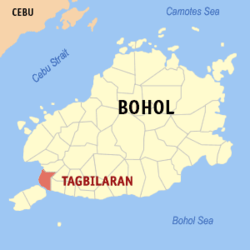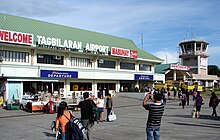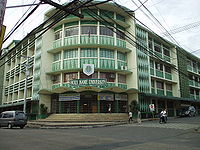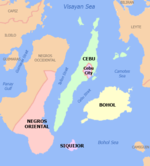Tagbilaran
This article includes a list of general references, but it lacks sufficient corresponding inline citations. (March 2012) |
Tagbilaran
Dakbayan sa Tagbilaran Lungsod ng Tagbilaran | |
|---|---|
| City of Tagbilaran | |
 | |
|
| |
| Nickname(s): City of Peace and Friendship | |
 Map of Bohol showing the location of Tagbilaran City | |
| Country | |
| Region | Central Visayas (Region VII) |
| Province | |
| District | 1st |
| Incorporated | February 9, 1742 (town) |
| Incorporated | July 1, 1966 (city) |
| Barangays | 15 |
| Government | |
| • Type | Strong Mayor-Council |
| • Mayor | Atty. Toto Veloso (acting) |
| Area | |
| • Land | 32.70 km2 (12.63 sq mi) |
| Population (2010)[1] | |
| • Total | 96,792 |
| • Density | 2,960/km2 (7,700/sq mi) |
| Demonym | Tagbilaranons |
| Time zone | UTC+8 (PST) |
| Postal Code | 6300 |
| Area code | 38 |
| Website | www.tagbilaran.gov.ph |
Tagbilaran City is a 2nd class[2] component city in the island province of Bohol, Philippines, and serves as its capital. Tagbilaran lies on the southwestern part of the province, and has a total land area of 32.7 km², with about 13 km of coastline. The city is on the south of Cortes, southwest of Corella west of the town of Baclayon and is about 630 km southeast of Manila and 72 km south of Cebu City.
It is the principal gateway to Bohol and is known as the "City of Friendship". Tagbilaran is considered by the Institute for Solidarity in Asia as one of the eight Philippine Dream Cities, along with Samal, San Fernando, La Union, Cebu City, Iloilo City, Marikina, Naga, Calbayog City and Surigao City. It was also recognized as one of the 20 "Most Competitive Cities in the Philippines" and "Pinoy Cities on the Rise" in 2005 and 2007, and first in the Quality of Life Category for the same two years, awarded by the Asian Institute of Management (AIM) Policy Center.
History
A hundred years before Spaniards arrived in the Philippines, the settlement of which eventually became Tagbilaran City was already involved in trading with China and Malaysia. This early settlement had contact with the Spaniards in 1565, when the Spanish conquistador Miguel López de Legazpi and the native chieftain Datu Sikatuna pledged peace and cooperation through the famous blood compact.
(San Jose de) Tagbilaran was established as a town on February 9, 1742, by General Don Francisco Antonio Calderon de la Barca, Governor of the Visayas, who separated it from the town of Baclayon. The town was dedicated to St. Joseph the Worker. Since then it was part of the province of Bohol until it became a chartered city on July 1, 1966, by virtue of Republic Act No. 4660.
The city was occupied by the United States during the Philippine-American War and by Imperial Japan during World War II.
Historic events
One of the most important events in Philippine history (immortalized on canvass by the famous Filipino painter Juan Luna) was the blood compact between Datu Sikatuna, a local native chieftain, and Captain Miguel López de Legazpi, the Spanish explorer and colonizer. It took place in the coast of Bool, now a district of Tagbilaran, on March 16, 1565, a day after Legazpi and his crew of conquistadores on four ships chanced upon the shores of Bool during their trip to the province of Butuan from Camiguin Island because of strong southwest monsoon winds and low tide.
On that day, March 16, 1565, Legazpi with Fray Andres de Urdaneta and some of his crew set foot on land for an audience with the local chieftain Sikatuna. The two bands of different race and creed met a few hundred meters from the beach and, after a few pleasantries, the Basque seafarer and the chieftain of Bool sealed and strengthened their treaty of friendship in a historic blood compact. Sikatuna and Legazpi each made a cut on the left arm and collected the drop of blood into a single vessel mixed with wine. To honor this treaty of friendship, the late President Elpidio Quirino established the "Order of Sikatuna", a presidential award and decoration conferred upon visiting dignitaries. A marker now stands on the very spot where Sikatuna and Legaspi sealed that famous compact.
Another significant event that took place during the Japanese Occupation was the Battle of Ubujan wherein a guerrilla unit under the command of Captain Francisco Salazar (a.k.a. Vicente Cubello) engaged Japanese troops against overwhelming odds. It was a display of Boholano bravery against the well-equipped, well-trained Japanese soldiers.[3]
Government

Local Chief Executives of Tagbilaran (1742- )
The city is governed locally by a mayor, although historically by a Gobernadorcillo and Presidente Municipal afterwards.
See List of Mayor of Tagbilaran
Political subdivision
| Flag | |
| Hymn | Tagbilaran Hymn |
| Dance | Kuradang |
| Bird | Tailor bird (Tamsi) |
| Flower | Bougainvillea |
| Tree | Acacia |
| Plant | Golden Duranta |
| Fish | Danggit |
There are 15 barangays comprising Tagbilaran, with a population of 96,792[4] for the year 2010 census, with an annual growth rate of 3.6%. However, 41% of the entire population reside in the four urban districts where trade and commerce are concentrated.
| Barangay | Area (km²) |
Area rank |
Population (2007) |
Population rank |
Pop. density (per km²) |
Pop. density rank |
|---|---|---|---|---|---|---|
| Bool | ||||||
| Booy | ||||||
| Cabawan | ||||||
| Cogon | ||||||
| Dampas | ||||||
| Dao | ||||||
| Manga | ||||||
| Mansasa | ||||||
| Poblacion I | ||||||
| Poblacion II | ||||||
| Poblacion III | ||||||
| San Isidro | ||||||
| Taloto | ||||||
| Tiptip | ||||||
| Ubujan |
Economy
The City of Tagbilaran has that relative advantage as Bohol's main business capital and center of governance, education and transportation. It is on this climate that commerce and trade is very promising in the city, and business activities thrive in port towns (e.g. Ubay, Tubigon, Talibon, Jagna) known to be growth centers of the province.
Many residents of Tagbilaran City are considerably moneyed, but when it comes to business development, they become investment-shy. It is observable that dollar earners and entrepreneurs would rather save and bank their money rather than invest them for business endeavor. In the light of this situation, the inflow of investments from foreign investors are steadily pouring in to finance business ventures especially in the area of tourism.
The two local food delicacies, "Peanut Kisses" and "Edelweiss torta", were started and promoted by the Alvarez family.
For a city its size, Tagbilaran has more than 20 banking institutions serving its populace as well as the entire province. This is due to the "thriftiness" of Bol-anons and remittances received from locals working abroad who hail from the city and other towns in Bohol. The average household income is P 141,028.00/annum in 12,876 households.


Banking institutions
- Agri Business Rural Bank, Inc.
- Allied Bank
- Asia United Bank
- Banco de Oro (formerly Equitable PCI Bank)
- Bank of Calape
- Bank of Commerce
- Bank of the Philippine Islands
- China Banking Corporation
- City Savings Bank
- Cooperative Bank of Bohol
- Development Bank of the Philippines
- EastWest Bank
- First Consolidated Bank
- Greenbank
- Kauswagan Bank
- Land Bank of the Philippines
- Metropolitan Bank and Trust Company
- Philippine National Bank
- Philippine Postal Savings Bank
- Philippine Savings Bank (PSBank)
- Philippine Veterans Bank
- Queen City Development Bank
- Rizal Commercial Banking Corporation
- RCBC Savings Bank
- Security Bank Corporation
- UnionBank of the Philippines
- United Coconut Planters Bank
- WealthBank
Major Shopping Centers and Malls
- Island City Mall
- Bohol Quality Mall
- Alturas Supermarket
- NOVO Jeans & Shirts
- Plaza Marcela Discount Store
- Shoppers' Mart
- Tagbilaran City Square
- Unitop
- Tagbilaran North Town Center
Condominiums and Subdivisions
- Luiton Residences Tagbilaran
- Camella Homes
- Betlehem Garden Homes
- Lindaville
- Uptown Village
Transportation


Air
The city and the entire province of Bohol is mainly served by Tagbilaran Airport. Cebu Pacific Air using Airbus A319 and Airbus A320 have two flights daily, Philippine Airlines using Airbus A320 and Airbus A319 have three flights daily, Zest Airways using Airbus A320 have two flights daily and Airphil Express using Airbus A320 have two flights daily to Manila. Flights to and from Tagbilaran to Manila takes around 1 hour and 15 minutes.
Established in 2011, Mid-Sea Express, began to provide flights to and from Tagbilaran City to its neighbor Cebu City, as well as to Mindanao covering Cagayan de Oro City, Camiguin, and Davao City.
Sea
The Tagbilaran City Tourist Port serves boats plying the busy Cebu-Bohol sea traffic and major port cities in Mindanao. A fastcraft ferry ride from Cebu takes about 2 hours. OceanJet with five trips daily, SuperCat with three trips daily and Weesam Express with four trips daily are the fastcraft companies plying the Tagbilaran City to Cebu City route.
Land
Transportation within the city consists of tricycles, multicabs, jeepneys, buses, taxis and vans. Multicabs and jeepneys ply the longer routes while taxis and vans-for-hire are usually used for out-of-town travel. All of them are found in the Tagbilaran City Integrated Bus Terminal in Dao District. Bolanios Bus Lines, Mega Bus Lines, UltraBus Lines and Silver Star Bus Lines are the bus companies driving the Tagbilaran City to Metro Manila (Pasay City / Cubao, Quezon City) route with each bus line having at least one daily trip.
Climate
| Climate data for Tagbilaran City, Bohol, Philippines | |||||||||||||
|---|---|---|---|---|---|---|---|---|---|---|---|---|---|
| Month | Jan | Feb | Mar | Apr | May | Jun | Jul | Aug | Sep | Oct | Nov | Dec | Year |
| Mean daily maximum °C (°F) | 31 (87) |
31 (88) |
32 (90) |
33 (91) |
33 (92) |
33 (91) |
32 (90) |
33 (91) |
32 (90) |
32 (90) |
32 (89) |
31 (88) |
32.08 (89.75) |
| Mean daily minimum °C (°F) | 23 (73) |
23 (73) |
23 (74) |
24 (75) |
25 (77) |
25 (77) |
24 (76) |
25 (77) |
25 (77) |
24 (76) |
24 (75) |
23 (74) |
24 (75) |
| Average precipitation mm (inches) | 55 (2.16) |
64 (2.5) |
89 (3.51) |
54 (2.12) |
62 (2.45) |
96 (3.78) |
93 (3.65) |
85 (3.33) |
75 (2.95) |
118 (4.64) |
125 (4.91) |
101 (3.98) |
1,015 (39.98) |
| Source: http://weather.msn.com/local.aspx?&wealocations=wc%3a7544788&q=Tagbilaran%2c+PHL&setunit=F | |||||||||||||
Health
The city is served with a mix of public and private health care institutions that also cater to the health needs of the rest of the province. Complex major cases and services are sent to nearby Cebu City due to lack of facilities.
- Holy Name University Medical Center
- Borja Family Hospital Corporation
- Englewood Hospital
- Governor Celestino Gallares Memorial Regional Hospital (tertiary public)
- MMG Bohol Cooperative Hospital
- Ramiro Community Hospital (tertiary private)
- St Jude General Hospital
- Tagbilaran Community Hospital
- Tagbilaran Maternity and Children's Hospital
Education
As the capital of Bohol, Tagbilaran is the main center for education in the province. All of the province's universities are located in the city as well as other well-known institutions of learning.
Colleges and Universities


- AMA Computer Learning Center
- BIT International College (BIT-IC, formerly Bohol Institute of Technology, BIT)
- Bohol Technical Institute (BTI)
- Bohol Wisdom School
- Holy Name University
- Holy Spirit School of Tagbilaran
- Immaculate Heart of Mary Seminary (IHMS)
- Informatics Computer Institute
- PMI Colleges Bohol
- Systems Technology Institute (STI Colleges)
- University of Bohol
Tourism

The city is a start-off point to Bohol province's attractions: the Chocolate Hills, Tarsier, white sandy beaches, dive spots, heritage sites and old stone churches. Home to several hotels, resorts, and restaurants, the city has recently become a venue for national conventions and gatherings.
Festivals
This section needs expansion. You can help by adding to it. (May 2009) |
The Sandugo Festival is an annual celebration in Tagbilaran in commemoration of the blood compact between Miguel López de Legazpi and Datu Sikatuna in March 1565. The festival is celebrated every July to coincide with the month-long activities celebrating the city's Charter Day on July 1 and the Province's (Bohol) Day on July 22.
May 1 is celebrated as the city's fiesta in honor of its patron saint, St. Joseph the Worker.
Notable Tagbilaranons
- Jose A. Clarin (1879–1935) - Senator & Senate President ProTempore, Republic of the Philippines (1916–1935)
- Juan S. Torralba - Senator, Republic of the Philippines (1931–1937)
- Fermin S. Torralba - Secretary of the Philippine Senate (1931–1935)
- Constancio Chatto Torralba - Provincial Governor of Bohol from April 1975 to June 1992. Father of Sandugo
- Cecilio K. Putong - Secretary of Education (1952)
- Oscar Butron Glovasa - 1st Placer, 1968 Bar Exams
- Gabriel Torero Ingles - Associate Justice, Court of Appeals of the Philippines (2011–present)
References
- ^ "Philippine Census August 1, 2007 Official Count" (PDF).
- ^ About Tagbilaran. City Government of Tagbilaran, Bohol, Philippines.
- ^ History of Tagbilaran http://www.tagbilaran.gov.ph Retrieved December 6, 2009.
- ^ Philippine Census August 1, 2007 Official Count Retrieved April 4, 2012


